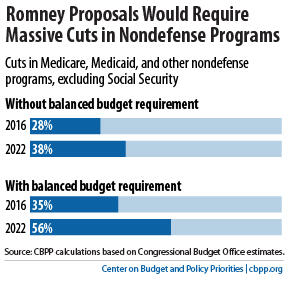BEYOND THE NUMBERS
An Updated Look at Governor Romney’s Budget Proposals
We’ve updated our analysis of Governor Mitt Romney’s budget proposals, which (as we said before) would require cutting nondefense discretionary spending to levels not seen in decades. Here’s the opening:

For the most part, Governor Romney has not outlined cuts in specific programs. But if policymakers exempted Social Security from the cuts, as Romney has suggested, and then cut Medicare, Medicaid, and all other nondefense programs by the same percentage, balancing the budget and adhering to the Romney spending cap would require cuts of 35 percent in 2016 and 56 percent in 2022. Without the balanced budget requirement, the cuts would be smaller but still massive — 28 percent in 2016 and 38 percent in 2022. These estimated cuts are somewhat larger than those that we published in an earlier version of this paper for reasons that we outline in Box 1 on page 4, including our use of the latest Congressional Budget Office (CBO) budget and economic projections.
For nondefense discretionary programs — those subject to annual appropriation — these cuts would come on top of the 11-percent cut already in law due to the discretionary funding caps of the Budget Control Act (BCA) that Congress enacted last August. Our estimates of the depth of cuts that the Romney proposals would require are consistent with what Governor Romney himself has said about the required cuts.
These cuts are far deeper than those that House Budget Committee Chairman Paul Ryan's (R-WI) austere budget plan would require. They would shrink nondefense discretionary spending — which, over the past 30 years, has averaged 3.7 percent of gross domestic product (GDP) and never fallen below 3.2 percent — to just 1.7 percent by 2022.
Click here for the full report.
